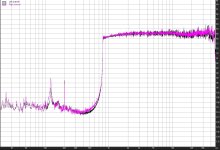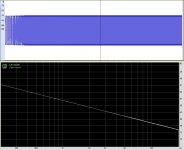I'm trying to measure FR of my phono playback system. I have a test record from Ortofon from 2016. It has frequency sweep tracks recorded with constant velocity.
Hypothetically, if these tracks are played by ideal cartridge through ideal RIAA preamp and recorded in Audacity, what is the expected form of the signal envelope? These are possible answers I could think of:
a) It would follow RIAA curve
b) It would be flat from start to finish
c) Something else
I already did such measurements with my cart and preamp, but the result is a bit strange, so I want to check if my interpretation is correct. I would appreciate your informed comments.
Hypothetically, if these tracks are played by ideal cartridge through ideal RIAA preamp and recorded in Audacity, what is the expected form of the signal envelope? These are possible answers I could think of:
a) It would follow RIAA curve
b) It would be flat from start to finish
c) Something else
I already did such measurements with my cart and preamp, but the result is a bit strange, so I want to check if my interpretation is correct. I would appreciate your informed comments.
Last edited:
A magnetic cartridge has a 6dB/octave rising frequency response to a groove of constant amplitude, and flat to a groove of constant velocity. That's why their sensitivity is measured in V/cm/sec.
So after your RIAA stage you should get an RIAA replay curve.
What anomalies are you seeing?
So after your RIAA stage you should get an RIAA replay curve.
What anomalies are you seeing?
That's my understanding to. But apparently response is rising with f. +2dB@2kHz, +3dB@5kHz, +4dB@10kHz, and so on. Measured also with linear preamp (no RIAA) with about the same result.
The strange thing is that compared to CD versions of the albums, LP-s sound subjectively subdued. The cartridge is Goldring 1012GX.
The strange thing is that compared to CD versions of the albums, LP-s sound subjectively subdued. The cartridge is Goldring 1012GX.
It cannot possibly be the same with a linear preamp unless your numbers refer to deviation from the RIAA curve. And there is something very strange about a 1dB/octave error.
If you're also hearing dull reproduction, either your RIAA implementation isn't correct, you cartridge is faulty, or your loading is wrong (which includes the cable).
If you're also hearing dull reproduction, either your RIAA implementation isn't correct, you cartridge is faulty, or your loading is wrong (which includes the cable).
Lots of phono cartridges have 4dB response deviation at the top end.
Some even more. Goldring's spec is +/-3dB, which allows for a total 6dB variation.
Is the loading set to the mfr spec of 47k and 100pF - 200pF ?
Some even more. Goldring's spec is +/-3dB, which allows for a total 6dB variation.
Is the loading set to the mfr spec of 47k and 100pF - 200pF ?
Last edited:
This is the test record with sweep going from 800Hz to 50KHz in 28 seconds, true ?I'm trying to measure FR of my phono playback system. I have a test record from Ortofon from 2016. It has frequency sweep tracks recorded with constant velocity.
Hypothetically, if these tracks are played by ideal cartridge through ideal RIAA preamp and recorded in Audacity, what is the expected form of the signal envelope? These are possible answers I could think of:
a) It would follow RIAA curve
b) It would be flat from start to finish
c) Something else
I already did such measurements with my cart and preamp, but the result is a bit strange, so I want to check if my interpretation is correct. I would appreciate your informed comments.
You mention to be looking in Audacity to the Signal Envelope, but be aware that the sweep is not linear but exponential in frequency, so halfway at 14 sec. it's not ca 25Khz but close to 5Khz.
Much better to get an idea what your Cart is doing, is to apply within Audacity a Anti Riaa operation on the recording under Effect/Filter curve EQ/Factory presets.
Hans
Many test LPs are not recorded with the RIAA curve. For example, CBS's STR-100.
https://www.discogs.com/master/615351-CBS-Laboratories-Stereophonic-Frequency-Test-Record-Issue-1
Left Sweep Frequency: 40-500 Cps Constant Amplitude, 500-20.000 Cps Constant Velocity; 1,000 Cps 0 Db Level
Regarding Ortofon's 2016 release,
https://www.discogs.com/release/11516219-Ortofon-Test-Record
"* The record has a constant velocity amplitude throughout the sweep."
I take the above to mean that the Ortofon is recorded with RIAA up to 800Hz, and with constant velocity amplitude from 800Hz~20kHz.
https://www.discogs.com/master/615351-CBS-Laboratories-Stereophonic-Frequency-Test-Record-Issue-1
Left Sweep Frequency: 40-500 Cps Constant Amplitude, 500-20.000 Cps Constant Velocity; 1,000 Cps 0 Db Level
Regarding Ortofon's 2016 release,
https://www.discogs.com/release/11516219-Ortofon-Test-Record
| A1 | Frequency Sweep Left Channel 800 Hz – 50 kHz. Log. 28 sec. Linear cut* (800 – 20000 Hz ±1,5 dB) |
I take the above to mean that the Ortofon is recorded with RIAA up to 800Hz, and with constant velocity amplitude from 800Hz~20kHz.
Hi Hans
Is this a playback with a magnetic pickup and a flat or a RIAA equalised preamplifier?
George
Is this a playback with a magnetic pickup and a flat or a RIAA equalised preamplifier?
George
Hi George,
It is played back with an MC cart on a flat preamp.
But because an exponential sweep has a spectrum showing a -10dB/dec downwards slope, I have multiplied the spectrum with a +10dB/dec upwards slope to get a flat spectrum, which is much easier to read.
Hans
It is played back with an MC cart on a flat preamp.
But because an exponential sweep has a spectrum showing a -10dB/dec downwards slope, I have multiplied the spectrum with a +10dB/dec upwards slope to get a flat spectrum, which is much easier to read.
Hans
Hans, please give more details. My understanding is that a logarithmic sweep (what is an exponential sweep?) has a frequency interval vs. time interval relation on the logarithmic scale. E.g. a sweep from 500Hz to 1kHz takes the same time as a sweep from 1kHz to 2kHz or from 2kHz to 4kHz, etc.
On the other hand I encountered with -10dB/decade (-3dB/octave) amplitude response at pink noise.
On the other hand I encountered with -10dB/decade (-3dB/octave) amplitude response at pink noise.
Hi Icsaszar,
A logarithmic sweep is the same as an exponential sweep or a chirp.
And yes, pink noise also has a -10dB/dec slope just because every octave or decade has the same power, just like in a chirp.
Have look at the image below, a chirp from 200Hz to 20Khz.
The upper part the shows the signal envelope, which is what you will see in time when using a constant velocity recording played over a flat preamp.
The lower part of the image shows the spectrum of the time signal, having a -10dB/dec slope.
Hans
A logarithmic sweep is the same as an exponential sweep or a chirp.
And yes, pink noise also has a -10dB/dec slope just because every octave or decade has the same power, just like in a chirp.
Have look at the image below, a chirp from 200Hz to 20Khz.
The upper part the shows the signal envelope, which is what you will see in time when using a constant velocity recording played over a flat preamp.
The lower part of the image shows the spectrum of the time signal, having a -10dB/dec slope.
Hans
Attachments
Last edited:
Sweep recorded with linear preamp (192kHz SR)

Let's take a pinch of it, select ~100ms somewhere and use Analyze -> Plot Spectrum feature in audacity:

Peak at 1001Hz suggests this is the part of the sweep around 1kHz. Now let's use Analyze -> Measure RMS option.

Write down (insert in spreadsheet) that value. Then continue doing the same in other parts of the sweep. With 10-15 evenly spaced measurements one can make a decent plot. Here is one made with 56k || 22pF + 110pF(cable) input impedance with a linear preamp (Left blue, Right red)

What surprises me the most is the deep below 2kHz. I don't know what causes it.
I have to clarify, the sound from LP I perceive as a kind of dull-ish when compared to CD. But it is evident only after comparison. Maybe this recessed mid is the cause of the subdued presentation.
Let's take a pinch of it, select ~100ms somewhere and use Analyze -> Plot Spectrum feature in audacity:
Peak at 1001Hz suggests this is the part of the sweep around 1kHz. Now let's use Analyze -> Measure RMS option.
Write down (insert in spreadsheet) that value. Then continue doing the same in other parts of the sweep. With 10-15 evenly spaced measurements one can make a decent plot. Here is one made with 56k || 22pF + 110pF(cable) input impedance with a linear preamp (Left blue, Right red)
What surprises me the most is the deep below 2kHz. I don't know what causes it.
I have to clarify, the sound from LP I perceive as a kind of dull-ish when compared to CD. But it is evident only after comparison. Maybe this recessed mid is the cause of the subdued presentation.
WHY, does the system sound wrong, what is the arm/cat & phono amp.
You may be wasting your time, as these never correlate to what you hear.
Cheers
You may be wasting your time, as these never correlate to what you hear.
Cheers
I'm not saying it sounds wrong. It's rather decent playback.
I'm just surprised by the result of the measurement as it contradicts what I hear. Hence, I wanted to check with you my friends if my interpretation is correct or if I'm missing something. And I have to admit, so deviant FR makes me feel uncomfortable.
My initial intention was to optimize cartridge load. Here is a set of measurements I made with various preamp input impedances (cable capacitance is additional 110pF). It appears FR is not much affected by small changes of the load. Recession below 2kHz cannot be fixed by load tuning.

I'm just surprised by the result of the measurement as it contradicts what I hear. Hence, I wanted to check with you my friends if my interpretation is correct or if I'm missing something. And I have to admit, so deviant FR makes me feel uncomfortable.
My initial intention was to optimize cartridge load. Here is a set of measurements I made with various preamp input impedances (cable capacitance is additional 110pF). It appears FR is not much affected by small changes of the load. Recession below 2kHz cannot be fixed by load tuning.
- Home
- Source & Line
- Analogue Source
- Ortofon test record

